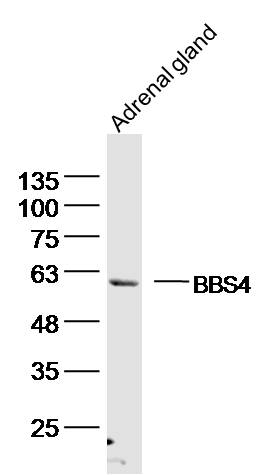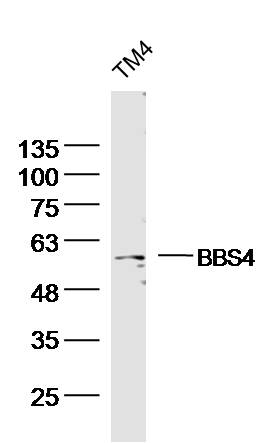
Rabbit Anti-BBS4 antibody
Bardet Biedl syndrome 4 protein; Bardet-Biedl syndrome 4 protein; Bbs4; BBS4_HUMAN.
View History [Clear]
Details
Product Name BBS4 Chinese Name 巴尔得-别德尔综合征相关蛋白4抗体 Alias Bardet Biedl syndrome 4 protein; Bardet-Biedl syndrome 4 protein; Bbs4; BBS4_HUMAN. Research Area Tumour Cell biology Neurobiology Endocrinopathy Immunogen Species Rabbit Clonality Polyclonal React Species Mouse, (predicted: Human, Rat, Dog, Pig, Cow, Horse, Sheep, ) Applications WB=1:500-2000 ELISA=1:5000-10000 IHC-P=1:100-500 IHC-F=1:100-500 ICC=1:100-500 IF=1:100-500 (Paraffin sections need antigen repair)
not yet tested in other applications.
optimal dilutions/concentrations should be determined by the end user.Theoretical molecular weight 58kDa Cellular localization cytoplasmic The cell membrane Form Liquid Concentration 1mg/ml immunogen KLH conjugated synthetic peptide derived from human BBS4: 431-519/519 Lsotype IgG Purification affinity purified by Protein A Buffer Solution 0.01M TBS(pH7.4) with 1% BSA, 0.03% Proclin300 and 50% Glycerol. Storage Shipped at 4℃. Store at -20 °C for one year. Avoid repeated freeze/thaw cycles. Attention This product as supplied is intended for research use only, not for use in human, therapeutic or diagnostic applications. PubMed PubMed Product Detail Bardet-Biedl syndrome (BBS) is a pleiotropic genetic disorder characterized by obesity, photoreceptor degeneration, polydactyly, hypogenitalism, renal abnormalities, and developmental delay. Other associated clinical findings in BBS patients include diabetes, hypertension, and congenital heart defects. BBS is a heterogeneous disorder; BBS genes map to eight genetic loci and encode eight proteins, BBS1-BBS8. Five BBS genes encode basal body or cilia proteins, suggesting that BBS is a ciliary dysfunction disorder. BBS4 is expressed in the olfactory epithelium and localizes to the centriolar satellites of centrosomes and basal bodies of primary cilia. BBS4 regulates the p150 subunit of the dynein transport machinery (DCTN1) to attract pericentriolar material-1 protein (PCM1) and its associated components to the satellites. Loss of BBS4 is correlated with obesity caused by abnormal lipid profiles, liver dysfunction, elevated insulin, and abnormal leptin levels.
Function:
May be required for the dynein-mediated transport of pericentriolar proteins to the centrosome. Required for microtubule anchoring at the centrosome but not for microtubule nucleation. The BBSome complex is required for ciliogenesis but is dispensable for centriolar satellite function. This ciliogenic function is mediated in part by the Rab8 GDP/GTP exchange factor, which localizes to the basal body and contacts the BBSome. Rab8(GTP) enters the primary cilium and promotes extension of the ciliary membrane. Firstly the BBSome associates with the ciliary membrane and binds to Rabin8, the guanosyl exchange factor (GEF) for Rab8 and then the Rab8-GTP localizes to the cilium and promotes docking and fusion of carrier vesicles to the base of the ciliary membrane.
Subunit:
Part of BBSome complex, that contains BBS1, BBS2, BBS4, BBS5, BBS7, BBS8, BBS9 and BBIP10. The BBSome complex binds to PCM1 and tubulin. Interacts with DCTN1. Interacts with CCDC28B.
Subcellular Location:
Cytoplasm, cytoskeleton, centrosome. Cytoplasm, cytoskeleton. Cell projection, cilium membrane. Cytoplasm. Note=Localizes to the pericentriolar region throughout the cell cycle. Centrosomal localization requires dynein. Localizes to nonmembranous centriolar satellites in the cytoplasm.
Tissue Specificity:
Ubiquitously expressed. The highest level of expression is found in the kidney.
DISEASE:
Defects in BBS4 are the cause of Bardet-Biedl syndrome type 4 (BBS4) [MIM:209900]. Bardet-Biedl syndrome (BBS) is a genetically heterogeneous, autosomal recessive disorder characterized by usually severe pigmentary retinopathy, early onset obesity, polydactyly, hypogenitalism, renal malformation and mental retardation. Secondary features include diabetes mellitus, hypertension and congenital heart disease. A relatively high incidence of BBS is found in the mixed Arab populations of Kuwait and in Bedouin tribes throughout the Middle East, most likely due to the high rate of consaguinity in these populations and a founder effect.
Similarity:
Belongs to the BBS4 family.
Contains 10 TPR repeats.
SWISS:
Q96RK4
Gene ID:
585
Database links:Entrez Gene: 585 Human
Entrez Gene: 102774 Mouse
Omim: 600374 Human
SwissProt: Q96RK4 Human
SwissProt: Q8C1Z7 Mouse
Unigene: 208681 Human
Product Picture
Primary: Anti-BBS4 (SL11508R) at 1/300 dilution
Secondary: IRDye800CW Goat Anti-Rabbit IgG at 1/20000 dilution
Predicted band size: 58 kD
Observed band size: 58 kD
Bought notes(bought amounts latest0)
No one bought this product
User Comment(Total0User Comment Num)
- No comment




 +86 571 56623320
+86 571 56623320
 +86 18668110335
+86 18668110335

